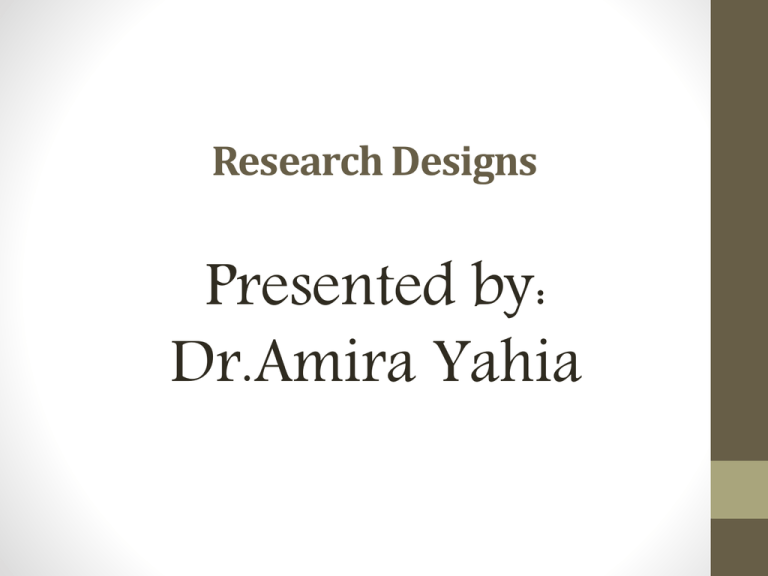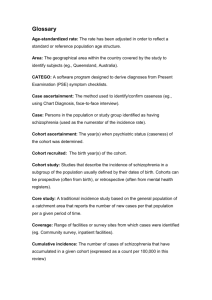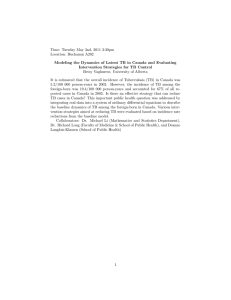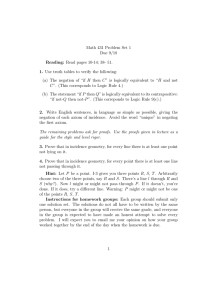Presented by: Dr.Amira Yahia Research Designs
advertisement

Research Designs Presented by: Dr.Amira Yahia Study designs Non intervention stud. Intervention stud. Exploratory stud. Case stud. Randomized control Trials Descriptive stud. Surveys Analytical stud. Case con. Stud. Cohort study Quazai experimental stud. Exploratory study Exploratory study It is a small - scale study of relatively short duration, which is carried out when little is known about a situation or a problem Exploratory studies problem is not as may be descriptive and/ analytical. If the problem is not well defined , it is always advisable to do an exploratory study. Exploratory study Example: One community with high and another with low participation in health activities, to identify the factors that contribute to community participation. DESCRIPTIVE STUDY DESIGNS: The systematic collection and presentation of data to give a clear picture of a specific disease or a health related events Case studies A case study describes in depth the characteristics of one or limited number of cases in its natural environment a/ Case studies Case studies -A case may be a patient, a health centre, a village etc… - Can provide useful insight into the problem e.g. a new disease - Common in clinical medicine, social sciences, management and administration etc.. - Associated with qualitative data and presentation is in a narrative way Case studies Features: - Should be well planned and data will be collected thorough predetermined questions - Should be flexible to deal with unexpected situations Case studies Advantage: - It permits a holistic approach to the problem under investigation Disadvantage: -Not representative b/ SURVEYS SURVEYS Use : 1. To collect information on demographic characteristics. Age, sex, education etc… 2. To study characteristics on health related variables. E.g. MMR, incidence rate, etc…. 3.To study attitudes, opinions and beliefs SURVEYS Surveys answer the following questions: - WHEN IS THE DISEASE OCCURRING? (TIME DISTRIBUTION) - WHERE IS THE DISEASE OCCURRING? (PLACE DISTRIBUTION) - WHO IS AFFECTED? (PERSON DISTRIBUTION) PROCEDURE 1- Define the problem under study 2- DEFINE THE POPULATION UNDER THE STUDY. 3- DESCRIBE THE DISEASE BY TIME, PERSON AND PLACE. 4- MEASUREMENT OF THE DISEASE. 5- COMPARING WITH KNOWN INDICES. 6- FORMULATION OF AN AETIOLOGICAL HYPOTHESIS. Cross-sectional designs: Involve the collection of data at one point in time: the phenomena under study are captured during one period of data collection. Cross-sectional studies are appropriate for describing the status of phenomena or for describing relationships among phenomena at a fixed point in time. CROSS SECTIONAL STUDY • PREVALENCE RATE STUDY • THE RELATIONSHIP BETWEEN THE DISEASE & OTHER VARIABLES OF INTEREST AS THEY EXIST AT ONE PARTICULAR POINT OF TIME CROSS SECTIONAL STUDY OF HYPERTENSION 1. 2. 3. 4. 5. MEASURE THE B.P. AMONG THE STUDY POPULATION (PREVALENCE.) COLLECT DATA ON AGE, SEX, SOCIAL CLASS , OCCUPATION etc... DETERMINE HOW HYPERTENSION IS RELATED TO THESE VARIABLES Compare with findings of others Draw hypothesis • Example of a cross-sectional study: Mindell and Jacobson (2000) assessed sleep patterns and the prevalence of sleep disorders during pregnancy. With a cross-sectional design, they compared women who were at four points in pregnancy: 8 to 12 weeks, 18 to 22 weeks; 25 to 28 weeks; and 35 to 38 weeks. The main advantage of cross-sectional designs in such situations is that they are practical: they are easy to do and are relatively economical • LONGITUDINAL STUDY DESIGNS • OBSERVATIONS ARE REPEATED IN THE SAME POPULATION OVER A PROLONGED PERIOD OF TIME THESE ARE USEFUL IN: • STUDY THE NATURAL HISTORY OF THE DISEASE. • IDENTIFY THE RISK FACTORS. • DETERMINE THE INCIDENCE RATE. Analytical studies 1. Case Control study Case Control study In Case Control Study, the investigator compare one group among which a problem present, with another group (control) where the problem is absent Common features 1. 2. 3. Both exposure and outcome have occurred before the start of the study Study proceeds back from effect to cause Presence of a control group Basic steps 1. 2. 3. 4. 5. Selection of cases Selection of controls Matching Obtaining data on exposure Analysis and interpretation of results Selection of cases It involves two specifications: 1. Diagnostic criteria: Specific diagnostic criteria of the disease, its staging are to be stated clearly. 2. Eligibility criteria: Criteria to determine who is allowed to be included in the study. E.g. Only newly diagnosed cases rather than old ones Sources of cases and controls Cases: - Patients - General population Controls: - Patients Relatives Neighbor hood General population Matching Is the process by which controls are to be similar to the study group Types: • Individual matching • Group matching Analysis: 1. The exposure rate among both the cases and the controls. 2. Odds ratio: This ratio can be used to estimate the relative risk as the incidence rate can not be determined in case-control study design. • Thus the case control study is always suggestive of the etiological association between two variables Strengths and limitations of the case-control study design Strengths: • Is relatively quick and inexpensive • Is optimal for the evaluation of rare diseases. • Can examine multiple etiologic factors for a single disease Limitations: • Is inefficient for the evaluation of rare exposures • Cannot directly compute incidence rates of disease in exposed and non- exposed individuals. • Is particularly prone to bias compared with other analytic designs, in particular, selection and recall bias. Analytical studies 2. Cohort study Cohort study • A longitudinal a study in which a group of individuals are followed up for some time. • A cohort is a group of persons who share common characteristics or experience within a defined time. Features The cohort is identified before the appearance of the investigated disease • The study groups are observed over a period of time • The study proceeds from cause to effect Note: The incidence rate can be measured • Indications of cohort study: 1. 2. 3. When there is strong suspicion of association between exposure and disease When exposure is rare but the incidence is high among the exposed When the attrition of study population can be minimized Types of Cohort studies -Historical Cohort study: Starts from a point in the past to now -Prospective Cohort study: Starts from now and study goes on to the future -Retrospective Prospective Cohort study: Starts from the past, passing through now and proceeds to the future Example of a prospective non experimental study: Brook, Sherman, Malen, and Kollef (2000) conducted a prospective cohort study to examine clinical and cost outcomes of early versus late tracheostomy in patients who require prolonged mechanical ventilation. Early tracheostomy was found to be associated with shorter lengths of hospital stay and lower hospital costs. Example of a retrospective study: • Heitkemper, Jarrett, Taylor, Walker, Landenburger, and Bond (2001) used a retrospective design in their study of factors contributing to the onset of irritable bowel syndrome (IBS). They compared samples of women with and without IBS in terms of their history of physical abuse, and found that abusive experiences were more prevalent among women with IBS Elements of a cohort study 1- Selection of a study group: From:- a. a general population or b. Special group (Such as doctors,Nurses, drivers etc.. or exposure group) 2- Obtaining data on exposure: By review of records , medical examination, interview etc… 3- Selection of a comparison group; -Internal comparisons: According to exposure level -External comparisons: From out side the study group Elements of a cohort study- cont. 4- Follow up: By: a. Periodic medical examination b. Review of records c. Review of death certificates d. Mailed questionnaires e. Telephone calls etc… 5- Analysis: a. Incidence rate b. Relative risk Analysis Relative risk: This is the ratio that measures the strength of association between suspected cause and effect. Attributable risk This is the difference in incidence of disease or death between exposed & non-exposed group. It is expressed as a percentage. It measures the impact that removal of a certain factor will have on the incidence of the disease. SMOKING & CA. LUNG Smoking status Developed Ca lung 70 (a) Did not develop Ca lung 6930 (b) Yes No Total 7000 (a+b) 3 © 2997 (d) 3000 (c+d) Analysis • Incidence rate of Ca lung among smokers= a/a+b=70/7000= 10/1000 • Incidence rate of Ca lung among non-smokers= c/c+d= 3/3000= 1/1000 Analysis • Relative risk= Incidence of disease among exposed: incidence among non-exposed 10/1000 1/1000 • Attributable risk= Incidence rate among exposed- incidence rate among non-exposed/incidence rate among exposed= 10-1x100=90%. Strengths and limitations of the cohort study design Strengths: • Is of particular value when the exposure is rare • Can examine multiple effects of a single exposure • Allows direct measurement of incidence of disease in the exposed and non-exposed groups. Limitations: • Is inefficient for the evaluation of rare diseases • Expensive and time consuming • Validity of the results can be seriously affected by losses to follow-up EXPERIMENTAL STUDY DESIGNS EXPERIMENTAL STUDY DESIGNS In experimental studies the researcher manipulates a situation and measures its effect after that Type: 1- Randomized control trials 2- Non-randomized trials 1- Randomized control trials RANDOMIZED CONTROLLED TRIALS Those trials are used for assessment of methods of treatment and prevention. They include: - intervention - control groups and - randomization Features of Randomized control trials 1- Manipulation: The researcher do some intervention (Example provision of new drug) to one of the study groups. 2- Control: The researcher introduces one or more control groups to compare with the experimental group 3- Randomization: Each subject have an equal chance of being allocated to either of the two groups( study and comparison groups) steps:1. Drawing a protocol. 2. Selecting comparison & experimental groups 3. Randomization. 4. Manipulation (intervention). 5. Follow up. 6. Assessment of the outcome. THE PROTOCL One of the essential features of the randomized trials. The protocol specifies: 1. The objectives. 2. The questions to be answered. 3. The selection criteria. 4. The sample size. 5. The procedures of allocation of the subjects into experimental and control groups. THE PROTOCL- cont. … 6. The treatment applied: How, what dose etc... 7. The details of the scientific techniques and investigations. Note: Once the protocol has been evolved, it should be strictly adhered to through out the study. RANDOMIZATION • Randomization is the statistical procedure by which the participants are allocated into groups usually called study & control groups to receive or not to receive intervention or therapeutic procedure . • Randomization aims at making the groups comparable and eliminate bias. RANDOMIZATION Randomization ensures that the investigator has no control over the allocation of the participants to either the study or control group, thus eliminating the selection bias. • Every individual has an equal chance of being allocated into either group. • Randomization is best done by using statistical random table. • MANIPULATION • Manipulation or intervention is usually done by application or withdrawal of the suspected factor e.g. drugs, vaccine or dietary factor. • This manipulation creates an independent variable (drug, vaccine or new procedure) which effect is then determined by the measurement of the final outcome which constitutes the dependent variable e.g. incidence of disease, recovery. FOLLOW UP • This includes examination of the study & control groups subjects at defined intervals of time in standard manner under the same conditions in the same time frame till the final assessment. • The main difficulties encountered in the follow up process include: Attrition from:- death, migration, displacement and loss of interest etc ASSESSMENT The final assessment of the trial is carried in terms of: • Positive results: These include the benefits of the experimental study such as reduced incidence of the disease or severity of the disease, cost of health services or other appropriate outcome. • Negative results: These include the severity & frequency of side-effects and complications. The incidence of positive/negative results is compared in both groups and the differences are tested statistically. 2- Non-randomized trials Quasi-experimental Quasi-experimental: A study in which subjects are not randomly assigned to treatment conditions, but the researcher does manipulate the independent variable and exercises certain controls to enhance the internal validates of the results. Types of quasi-experimental a. Non-equivalent groups or static groups design Two receive different treatments, but are not randomly assigned or matched to conditions. Eliminates history effects but not subject effects. b. Time-series design There is one group of research participants with several baseline measures, “a treatment and at least one more measurement eliminates subject effects but not history effects. a. QUASI-EXPERIMENTAL STUDY DESIGNS • At least one of the characteristics of the true experiment is missing (RANDOMIZATION OR CONTROL GROUP) • QUASI-EXPERIMENTAL STUDY DESIGNS ALWAYS INCLUDES MANIPULATION ( INTERVENTION) 2. Non-randomized trials b. Before and after study: - Includes intervention - No control group - No randomization - Observation before and after the intervention - Test ( analysis) Bias in experimental studies • Bias is the systematic difference between observed results and the actual results. • Sources of bias: 1. Participant’s bias: The participants report subjectively that they feel better or improved if they knew that they were receiving new treatment. BIAS – cont. .. 2.Observer’s bias: The influence of the investigator measuring the outcome of the trial if he knew beforehand the particular procedure to which the patient has been subjected. How to reduce the sources of bias? 1. Randomization. 2. Blinding. Blinding is carried in three ways: 1. Single blind trial: The trial is so planned that the participant is not aware whether he belongs to the study or control group. 2. Double blind trial: The trial is so planned that neither the doctor nor the participant is aware of the group allocation and treatment received. How to reduce the sources of bias? Cont… 3. Triple-blind trial: The trial is so planned that the participant, the investigator& the person analyzing the data are all blind. This is the ideal but double-blinding is the most commonly used. DISADVANTAGES OF EXPERIMENTAL STUDIES • They are costly. • Ethical problems. • Feasibility is difficult. Qualitative design: Qualitative research: The investigation of phenomena, typically in an in depth and holistic fashion, through the collection of rich narrative materials using a flexible research design. Qualitative research types 1-Phenomenology: a form of qualitative research in which the researcher attempts to understand how one or more individuals experience a phenomenon. For example: you might interview 20 widow and ask them to describe their experiences of deaths of their husbands 2-Ethnography: is the form of qualitative research that focuses on describing the culture of a group of people. • For example, you might decide to go and live in a Mohawk communities and study the culture and their educational practices • 3-Case study research: is a form of qualitative research that is focused on providing a detailed account of one or more cases. • For example, you might study a classroom that was given a new curriculum for technology use. 4-Grounded theory: is a qualitative approach to generating and developing a theory form data that the researcher collects. • For example, you might collect data from parents who have pulled their children out of public schools and develop a theory to explain how and why this phenomenon occurs, ultimately developing a theory of school pull-out • 5-Historical research: research about events that occurred in the past. • For example, you might study the use of corporeal punishment in schools in the 19th century. Mixed research methods: • It is a general type of research “it’s one of the three paradigms” in which quantitative and qualitative methods are mixed in one overall study. • i.e. it is research in which the researcher uses the qualitative research paradigm for one phase of a research study and the quantitative research paradigm for another phase of the study. • For example, a researcher might conduct an experiment (quantitative) and after the experiment conduct an interview study with the participants to see how they viewed the experiment and to see if they agreed with the results.



